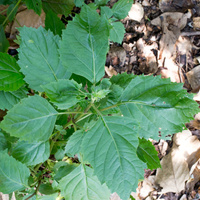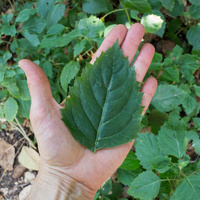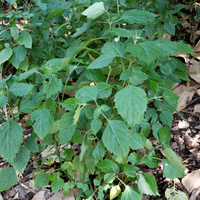Common name: Patchouli
Other common names: East Indian mint, Patchouly
Description
East Indian Mint (aka. Patchouli) is a mint relative originating from the Philippines but cultivated today in Southeast Asia, Africa, India and South America for its stems and leaves, which yield an essential oil used in the food and fragrance industries.
It is a much-branched herbaceous shrub 0.5 to 1 m (1.5 to 3.5 ft) tall with a bushy appearance. The foliage is mint-like, with square stems and soft, fine hairs on both the stems and leaves.
Leaves dull dark green, heart-shaped, 5 to 10 cm (2 to 4 in) long and toothed along the margins. All parts of the plant give off a sweet fragrance when crushed.
The flowers are small, bisexual, white, pink or pale purple and borne on tall, narrow spikes that grow above the foliage, blooming from late autumn to winter.
Use
The leaves and young shoots yield on steam distillation a viscous, yellow-green to brown essential oil traded as 'Patchouli oil'. It is used mainly as a fragrance and flavouring component in food, perfume and personal care products. Its persistent, woody aroma was at one time widely used to scent men's grooming products, such as aftershave, as well as other male toiletry products. The fragrance notes of the oil reportedly improve with age.
The dried leaves and stems are also valued for their fragrance. They are used in clothing and linen cupboards in its native range as a deodoriser and to repel fabric eating insects, such as clothes moths.
Around 2,000 kilograms of dried leaves are produced per hectare per year in commercial operations and, with an oil content of 2.5 to 3.0%, yield approximately 50 to 60 kilograms of oil (45 to 54 pounds per acre).
Climate
Grows naturally and develops leaves with a high oil content in humid tropical lowland to mid-elevation climates, generally areas with annual lows of 18 to 25°C, annual highs of 27 to 35°C, annual rainfall of 1500 to 4000 mm and a dry season of 5 months or less.
Patchouli is also cultivated with irrigation in drier areas, such as around Bangalore (in Karnataka state, India), which has annual rainfall of 923 mm and a dry season lasting 5 months.
Growing
New plants are usually grown from cuttings, as seed are rarely produced. It performs best on rich, free-draining clay-loam, loam, sandy-loam and loamy-sand soils of a moderately acid to slightly acid nature, generally with a pH of 5.5 to 6.5.
In the lowland tropics, it is commonly cultivated as an understory plant, usually beneath tall and widely spaced timber and coconut trees because of the shade they provide. Shading is less of a requirement in elevated tropical and subtropical areas, and the plants are grown in full sun.
Leaf harvesting in commercial operations starts when the plants are around six months old, with harvesting repeated every three to four months after that. The leaves are selected when they become pale green to light brown and when the whole bush releases its characteristic aroma, usually around early to mid-morning. The harvested leaves are then shade dried, bagged and left to ferment for a short time, which reportedly increases their oil yield at distillation.
It is a short-lived perennial that loses its vigour after around three years and needs replacing with new plants.
Problem features
Patchouli is listed as a weed in at least one reference publication. Still, there does not appear to be any record of it as a serious weed anywhere in the world, and this may be due, in part, to its shy seeding habit.
Where it grows
References
Books
-
Axtell, B. L & Fairman, R. M 1992, Minor oil crops, Food and Agriculture Organization of the United Nations (FAO), Rome
-
Brown, William Henry. 1920, Minor products of Philippine forests, Bureau of Printing, Manila
-
Chevallier, A. 2000, Encyclopedia of herbal medicine, 2nd American ed., Dorling Kindersley, New York
-
Debboun, M. & Frances, S. P. & Strickman, D. 2006, Insect repellents : principles, methods, and uses, CRC Press, Boca Raton, Florida
-
Farooqi, A. A. & Sreeramu, B. S. 2004, Cultivation of medicinal and aromatic crops, Hyderabad University Press, Hyderabad
-
Groom, N. 1997, The new perfume handbook, 2nd ed., Blackie Academic & Professional, London
-
Hill, A. F. 1952, Economic botany : a textbook of useful plants and plant products, 2nd ed, McGraw-Hill, New York
-
Jones, M. 2011, The complete guide to creating oils, soaps, creams, and herbal gels for your mind and body : 101 natural body care recipes, Atlantic Publishing Group, Ocala, Florida
-
Khan, I. A. & Abourashed, E. A. 2010, Leung's encyclopedia of common natural ingredients : used in food, drugs and cosmetics, 3rd edition, Wiley Publishing, Hoboken, New Jersey
-
National Institute of Industrial Research (India) 2005, Cultivation of tropical, subtropical vegetables, spices, medicinal, and aromatic plants, Delhi, India
-
Oyen, L. P. A. & Nguyen X. D. 1999, Plant Resources of South-East Asia (PROSEA) 19 : Essential-oil plants, Backhuys Publishers, Leiden
-
Randall, R. P. 2002, A global compendium of weeds, R.G. and F.J. Richardson Press, Melbourne
-
Randall, R. P. 2007, The introduced flora of Australia and its weed status, Cooperative Research Centre for Australian Weed Management, Glen Osmond, South Australia




